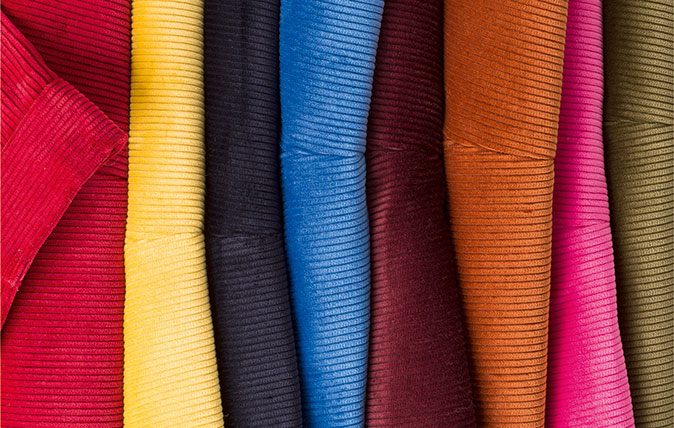In praise of cords: Colourful, practical, and ‘the perfect country trousers’
Sometimes custard yellow, but always soft and snug, corduroy is one of the most pleasing materials in a countryman’s wardrobe, finds Alec Marsh.


Aside from tweed, corduroy is the countryside’s king of cloths, comfortable, warm and pleasingly weatherproof. The pair of trousers I wore to cycle from London to Brighton when accompanying a vintage-car rally didn’t let me down, even in the driving rain.
We might never know the true origin of this finely ribbed fustian (a woven cotton cloth), but modern opinion sadly finds against the theory of the king’s cloth – corde du roi is not an expression known across the Channel. What we do know is that Britons have been wearing it with pride since the 1700s.
"They’re the perfect country trousers"
Eric Clapton
Rory Stewart, the intrepid Minister for International Development and Conservative MP for Penrith and the Border, is a definite fan. A committed countryman, Mr Stewart has walked some 6,000 miles across Asia and has covered about 1,000 miles of Britain on foot, too – often in a pair of cords.
‘They’re more comfortable than jeans and look a bit more formal,’ explains Mr Stewart, who favours shades of dark blue and brown.
‘They also allow you to look and feel a more traditional part of the British landscape than [by] wearing a pair of waterproof trousers,’ adds the politician.
This is music to the ears of the team at Brisbane Moss in Yorkshire’s Calder Valley, which has been making and supplying the finest corduroy for more than 150 years.
| Where to buy cracking cordsCordings of PiccadillyWith colours including cinnamon, berry, fuchsia, Bordeaux and more, this is the place to get cords made with fabric from Brisbane Moss, priced at £110 (020–7758 4122; www.cordings.co.uk)Joseph Turner of YorkshireWith a broad range of colours and cloth sourced from Brisbane Moss, priced at £99.20 (01845 575100; www.josephturner.co.uk)Oliver BrownAlways worth checking for cords in some seriously bright hues, priced at £95. Dare you? (020–7259 9494; www.oliverbrown.org.uk)BarbourFamous for waxed jackets, the clothing range also includes a contemporary take on cords that’s worthy of consideration (0800 917 3000; www.barbour.com) |
Today, it stocks more than 400 different types, categorised by colour, quality and number of wales (the ribs or piles, which are numbered per inch). In the warehouse is some 273,000 yards of the stuff – enough to carpet Trafalgar Square 30 times over. ‘It’s a lot of cloth,’ confirms the company’s Robert Smithies, who explains that the material is available in 21 different weights and widths of wale, which typically range from four to 21.
Sign up for the Country Life Newsletter
Exquisite houses, the beauty of Nature, and how to get the most from your life, straight to your inbox.
‘We do an eight wale that’s 470g (17oz) per square metre and is our flagship quality. It’s a very heavy, traditional corduroy that people around the world buy because they want that solid Britishness.’ For him, what makes the material special is how it’s made.
‘Some of the threads that run across the cloth – the wefts – are cut on a machine after it comes off the loom and it’s those that stand up and make the pile,’ elaborates Mr Smithies.
‘The fibres and threads stand up vertically from the surface, therefore you get a density of colour that you don’t get in a flat fabric.’ What makes it such a decidedly country cloth? ‘It’s a cotton fabric, so it’s not overly heavy and doesn’t rustle when you move, yet it gives warmth because it’s got that pile. It’s also densely woven and relatively windproof.’
Over at Barbour in South Shields, outside Newcastle, corduroy has been used on the collars of its world-renowned waxed coats since the 1950s, with some examples from the 1930s, according to Design and Development Manager Gary Janes. ‘We tend to use eight wale, which has more pile and is more luxurious,’ he explains. ‘It doesn’t bald and seems to last the lifetime of the garment, which can be decades. It does change with wear, but that’s the beauty of it.’
Crucially, the collar provides a barrier against the waxed cotton, which is especially useful if it’s wet, and aesthetics also play a part – Mr Janes compares the grooves in the material to the furrows of a ploughed field.
"They're very good trousers to wear when you’re reading Country Life"
Alexander McCall Smith
A hundred miles north in Edinburgh, the writer Alexander McCall Smith is such a fan that he’s written a ‘Corduroy Mansions’ series of novels as well as name-checking the fabric in his ‘44 Scotland Street’ stories, where, alongside ‘crushed strawberry’, the material appears in ‘distressed outmeal’ and ‘mitigated beige’.
‘There’s a very interesting question about the colour of corduroy that you wear,’ states Mr McCall Smith (Country Life, March 2, 2016). ‘Red makes a statement: in Edinburgh, red trousers are worn on the northern side of Princes Street, but you don’t really see them on the south.’
Admitting to ‘having worn crushed strawberry from time to time, and I have also got a darker red, which I wear at our house in Argyll – it’s very remote, so you’re effectively wearing them in private’, the author adds that ‘they’re also very good trousers to wear when you’re reading Country Life’.
It is far from Princes Street, either north or south, however, that you’ll find arguably the world’s greatest selection, in the subterranean menswear department of Cordings of Piccadilly, London W1. Stretched before you like the colours of the rainbow, this is to a cord lover what Graceland is to fans of Elvis.
‘They’re the perfect country trousers,’ declares the establishment’s joint managing director, the rock musician and guitarist Eric Clapton.
‘They look great and do the job better than any of the alternatives.’ And that’s coming from a man who knows his cords better than most.

Eric Clapton: He knows cords just as well as he knows chords
Country Life is unlike any other magazine: the only glossy weekly on the newsstand and the only magazine that has been guest-edited by HRH The King not once, but twice. It is a celebration of modern rural life and all its diverse joys and pleasures — that was first published in Queen Victoria's Diamond Jubilee year. Our eclectic mixture of witty and informative content — from the most up-to-date property news and commentary and a coveted glimpse inside some of the UK's best houses and gardens, to gardening, the arts and interior design, written by experts in their field — still cannot be found in print or online, anywhere else.
-
 'To exist in this world relies on the hands of others': Roger Powell and modern British bookbinding
'To exist in this world relies on the hands of others': Roger Powell and modern British bookbindingAn exhibition on the legendary bookbinder Roger Powell reveals not only his great skill, but serves to reconnect us with the joy, power and importance of real craftsmanship.
By Hussein Kesvani
-
 Spam: The tinned meaty treat that brought a taste of the ‘hot-dog life of Hollywood’ to war-weary Britain
Spam: The tinned meaty treat that brought a taste of the ‘hot-dog life of Hollywood’ to war-weary BritainCourtesy of our ‘special relationship’ with the US, Spam was a culinary phenomenon, says Mary Greene. So much so that in 1944, London’s Simpson’s, renowned for its roast beef, was offering creamed Spam casserole instead.
By Country Life